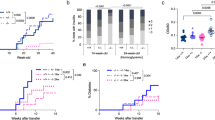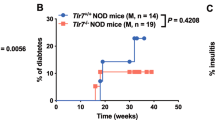Abstract
Diabetes in non-obese diabetic (NOD) mice is mediated by pathogenic T-helper type 1 (Th1) cells that arise because of a deficiency in regulatory or suppressor T cells1,2. Vα14–Jα15 natural killer T (NKT) cells recognize lipid antigens presented by the major histocompatibility complex class I-like protein CD1d (refs. 3,4). We have previously shown that in vivo activation of Vα14 NKT cells by α-galactosylceramide (α-GalCer) and CD1d potentiates Th2-mediated adaptive immune responses5,6. Here we show that α-GalCer prevents development of diabetes in wild-type but not CD1d-deficient NOD mice. Disease prevention correlated with the ability of α-GalCer to suppress interferon-γ but not interleukin-4 production by NKT cells, to increase serum immunoglobulin E levels, and to promote the generation of islet autoantigen-specific Th2 cells. Because α-GalCer recognition by NKT cells is conserved among mice and humans7,8, these findings indicate that α-GalCer might be useful for therapeutic intervention in human diseases characterized by Th1-mediated pathology such as Type 1 diabetes.
This is a preview of subscription content, access via your institution
Access options
Subscribe to this journal
Receive 12 print issues and online access
$209.00 per year
only $17.42 per issue
Buy this article
- Purchase on Springer Link
- Instant access to full article PDF
Prices may be subject to local taxes which are calculated during checkout



Similar content being viewed by others
References
Delovitch, T.L. & Singh, B. The nonobese diabetic mouse as a model of autoimmune diabetes: immune dysregulation gets the NOD. Immunity 7, 727–738 (1997).
Bach, J.-F. & Chatenoud, L. Tolerance to islet autoantigens in type 1 diabetes. Annu. Rev. Immunol. 19, 131–161 (2001).
Godfrey, D.I., Hammond, K.J., Poulton, L.D., Smyth, M.J. & Baxter, A.G. NKT cells: facts, functions and fallacies. Immunol. Today 21, 573–583 (2000).
Kawano, T. et al. CD1d1-restricted and TCR-mediated activation of Vα14 NKT cells by glycosylceramides. Science 278, 1626–1629 (1997).
Singh, N. et al. Activation of NK T cells by CD1d and α-galactosylceramide directs conventional T cells to the acquisition of a Th2 phenotype. J. Immunol. 163, 2373–2377 (1999).
Burdin, N., Brossay, L. & Kronenberg, M. Immunization with α-galactosylceramide polarizes CD1-reactive NK T cells towards Th2 cytokine synthesis. Eur. J. Immunol. 29, 2014–2025 (1999).
Brossay, L. et al. CD1d-mediated recognition of an α-galactosylceramide by natural killer T cells is highly conserved through mammalian evolution. J. Exp. Med. 188, 1521–1528 (1998).
Spada, F.M., Koezuka, Y. & Porcelli, S.A. CD1d-restricted recognition of synthetic glycolipid antigens by human natural killer T cells. J. Exp. Med. 188, 1529–1534 (1998).
Gombert, J.-M. et al. Early quantitative and functional deficiency of NK1+-like thymocytes in the NOD mouse. Eur. J. Immunol. 26, 2989–2998 (1996).
Baxter, A.G. et al. An association between αβTCR+CD4−CD8− T cell deficiency and IDDM in NOD/Lt mice. Diabetes 46, 572–582 (1996).
Falcone, M., Yeung, B., Tucker, L., Rodriguez, E. & Sarvetnick, N. A defect in interleukin 12-induced activation and interferon γ secretion of peripheral natural killer T cells in nonobese diabetic mice suggests new pathogenic mechanisms for insulin-dependent diabetes mellitus. J. Exp. Med. 190, 963–972 (1999).
Matsuda, J.L. et al. Tracking the response of natural killer T cells to a glycolipid antigen using CD1d tetramers. J. Exp. Med. 192, 741–754 (2000).
Benlagha, K., Weiss, A., Beavis, A., Teyton, L. & Bendelac, A. In vivo identification of glycolipid antigen-specific T cells using fluorescent CD1d tetramers. J. Exp. Med. 191, 1895–1903 (2000).
Pearson, C.I. & McDevitt, H.O. Redirecting Th1 and Th2 responses in autoimmune disease. Curr. Top. Microbiol. Immunol. 238, 79–122 (1999).
Mendiratta, S.K. et al. CD1d1 mutant mice are deficient in natural T cells that promptly produce IL-4. Immunity 6, 469–477 (1997).
Shi, F.-D. et al. Germ line deletion of the CD1 locus exacerbates diabetes in the NOD mouse. Proc. Natl. Acad. Sci. USA 98, 6777–6782 (2001).
Salomon, B. et al. B7/CD28 costimulation is essential for the homeostasis of the CD4+CD25+ immunoregulatory T cells that control autoimmune diabetes. Immunity 12, 431–440 (2000).
Hammond, K.J.L. et al. α/β-T cell receptor (TCR)+ CD4−CD8− (NKT) thymocytes prevent insulin-dependent diabetes mellitus in non-obese diabetic (NOD)/Lt mice by the influence of interleukin (IL)-4 and/or IL-10. J. Exp. Med. 187, 1047–1056 (1998).
Laloux, V., Beaudoin, L., Jeske, D., Carnaud, C. & Lehuen, A. NK T cell-induced protection against diabetes in Vα14-Jα281 transgenic nonobese diabetic mice is associated with a Th2 shift circumscribed regionally to the islets and functionally to islet autoantigen. J. Immunol. 166, 3749–3756 (2001).
Osman, Y. et al. Activation of hepatic NKT cells and subsequent liver injury following administration of α-galactosylceramide. Eur. J. Immunol. 30, 1919–1928 (2000).
Morita, M. et al. Structure-function relationship of α-galactosylceramides against B16-bearing mice. J. Med. Chem. 38, 2176–2187 (1995).
Sonoda, K.H., Exley, M., Snapper, S., Balk, S.P. & Stein-Streilein, J. CD1-reactive natural killer T cells are required for development of systemic tolerance through an immune-privileged site. J. Exp. Med. 190, 1215–1226 (1999).
Terabe, M. et al. NKT cell-mediated repression of tumor surveillance by IL-13 and the IL-4R-STAT6 pathway. Nature Immunol. 1, 515–520 (2000).
Moodycliffe, A.M., Nghiem, D., Clydesdale, G. & Ullrich, S.E. Immune suppression and skin cancer development: regulation by NKT cells. Nature Immunol. 1, 521–525 (2000).
Sharif, S. et al. Activation of natural killer T cells by α-galactosylceramide treatment prevents the onset and recurrence of autoimmune type 1 diabetes. Nature Med. 7, 1057–1062 (2001).
Acknowledgements
We thank A.C. Powers for helpful suggestions; M. Nadaf for help with flow cytometry; C. Marlar for critical reading of the manuscript; and A. Herbelin, J.-F. Bach and T. Delovitch for sharing information prior to publication. This work was supported in part by a discovery grant from the Diabetes Research and Training Center at Vanderbilt University (to L.V.K.).
Author information
Authors and Affiliations
Corresponding author
Rights and permissions
About this article
Cite this article
Hong, S., Wilson, M., Serizawa, I. et al. The natural killer T-cell ligand α-galactosylceramide prevents autoimmune diabetes in non-obese diabetic mice. Nat Med 7, 1052–1056 (2001). https://doi.org/10.1038/nm0901-1052
Received:
Accepted:
Issue Date:
DOI: https://doi.org/10.1038/nm0901-1052
This article is cited by
-
Repeated administration of alpha-galactosylceramide ameliorates experimental lupus nephritis in mice
Scientific Reports (2018)
-
Functional role of natural killer T cells in non-obese pre-diabetes model mice
Cytotechnology (2018)
-
A locus on mouse chromosome 13 inversely regulates CD1d expression and the development of invariant natural killer T-cells
Genes & Immunity (2015)
-
Natural killer T cells: drivers or passengers in preventing human disease?
Nature Reviews Immunology (2014)
-
Genetic control of murine invariant natural killer T cells maps to multiple type 1 diabetes regions
Genes & Immunity (2013)



